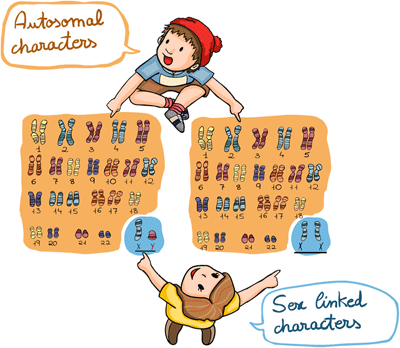Types of inheritance
In terms of heredity, and following this classification, the recipes that determine the characteristics or traits for each person are divided into AUTOSOMAL characteristics, if they are contained in the first 22 sets of chromosomes.
And SEX LINKED characteristics, if they are part of set 23. Within this group, we will only work with those recipes or traits that are “X”-chromosome dependent, as this chromosome is shared equally by the male and the female’s sex-chromosomes. When discussing these recipes, we will refer to them as traits or characters linked to the X-chromosome.
Conversely, traits that are “Y”-chromosome dependent are only transmitted from male to male, and will not be discussed here.

This whole array of characteristics or traits can manifest or express in a dominant, recessive, co-dominant, or intermediate fashion.

The terms “dominant and recessive” mean that we receive the information from a recipe twice, information from the father and information from the mother, as each of them contributes with one element from each set of their chromosomes. Then, and depending on how the information contained in those recipes manifests or is expressed, we can be faced with four different scenarios:
A DOMINANT character or trait is when only one of the two recipes is expressed, be it the mother’s or the father’s, with one dominating over the other
 The other recipe that is not being expressed at this moment but that belongs to the same chromosomal set (although it did not manifest in the presence of the other recipe) is called RECESSIVE character or trait because it is in RECESS, overlapping or hidden. In this case, for the character to manifest it is necessary for both progenitors to contribute with the same type of information. If only one of the progenitors provides the required information, the character does not manifest and then the individual is considered to be an asymptomatic carrier of such character or trait.
The other recipe that is not being expressed at this moment but that belongs to the same chromosomal set (although it did not manifest in the presence of the other recipe) is called RECESSIVE character or trait because it is in RECESS, overlapping or hidden. In this case, for the character to manifest it is necessary for both progenitors to contribute with the same type of information. If only one of the progenitors provides the required information, the character does not manifest and then the individual is considered to be an asymptomatic carrier of such character or trait.
When both recipes are identical and are present twice are called RECESSIVE characters or traits
 That is the trait that was not expressed
That is the trait that was not expressedbefore because it was in RECESS,
that is, overlapped or hidden, because
there was another trait that dominated
over it, preventing its expression
 Now, the situation has changed
Now, the situation has changedand it is present twice, e.g. both recipes
provide or codify the same type
of information
And, because neither dominates one over the other as they both carry the same contents, the trait WILL indeed express itself. In this instance, “blond hair”.
When both recipes are expressed at the same time with the same intensity
They are called CO-DOMINANT CHARACTERS, as in the AB blood type.
When both recipes are expressed at the same time but the resulting character or trait is an intermediate expression of both, because neither dominates over the other;
These characters are said to present an INCOMPLETE OR PARTIAL DOMINANCE, for instance if we cross-breed white flowers with red flowers, the descendants will have pink flowers. The pink flowers are the result of mixing up both pigments.
And do you want to know how this type of heredity was discovered?
It was Gregory Mendel, an Austrian Augustinian monk born in 1822, whom, while growing peas in his garden, discovered the laws that bear their last name and that constitute the corner stone of genetic science. Mendel crossed pure pea types that differed in one or more defined traits. Mendel followed for at least two generations the progenesis of this plant crossings.
In the year 1866 he had already published the results of the experiments that delineated the majority of the basic principles of classic genetics. However, at that time, the world was not yet ready to pay attention to Mendel´s great work. His discoveries were not recognised until much later after his death.
Next topic: Why do disorders develop?
Reviewed: 23rd of January 2015
